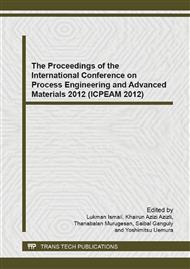[1]
S. A. Hashemifard, A. F. Ismail, and T. Matsuura, Prediction of gas permeability in mixed matrix membranes using theoretical models, J. Membr. Sci. 347 (2010) 53-61.
DOI: 10.1016/j.memsci.2009.10.005
Google Scholar
[2]
P. Rajinder, Permeation models for mixed matrix membranes, J. Colloid Interface Sci. 317 (2008) 191-198.
Google Scholar
[3]
C. J. Cornelius and E. Marand, Hybrid silica-polyimide composite membranes: gas transport properties, J. Membr. Sci. 202 (2002) 97-118.
DOI: 10.1016/s0376-7388(01)00734-7
Google Scholar
[4]
A. F. Ismail and P. Y. Lai, Effects of phase inversion and rheological factors on formation of defect-free and ultrathin-skinned asymmetric polysulfone membranes for gas separation, Sep. Purif. Technol. 33 (2003) 127-143.
DOI: 10.1016/s1383-5866(02)00201-0
Google Scholar
[5]
Y. Xiao, B. T. Low, S. S. Hosseini, T. S. Chung, and D. R. Paul, The strategies of molecular architecture and modification of polyimide-based membranes for CO2 removal from natural gas—A review, Prog. Polym. Sci. 34 (2009) 561-580.
DOI: 10.1016/j.progpolymsci.2008.12.004
Google Scholar
[6]
K. -S. Jang, H. -J. Kim, J. R. Johnson, W. -g. Kim, W. J. Koros, C. W. Jones, and S. Nair, Modified Mesoporous Silica Gas Separation Membranes on Polymeric Hollow Fibers, Chem. Mater. 23 (2011) 3025-3028.
DOI: 10.1021/cm200939d
Google Scholar
[7]
D. Q. Vu, W. J. Koros, and S. J. Miller, Mixed matrix membranes using carbon molecular sieves: II. Modeling permeation behavior, J. Membr. Sci. 211 (2003) 335-348.
DOI: 10.1016/s0376-7388(02)00425-8
Google Scholar
[8]
M. A. Aroon, A. F. Ismail, T. Matsuura, and M. M. Montazer-Rahmati, Performance studies of mixed matrix membranes for gas separation: A review, Sep. Purif. Technol. 75 (2010) 229-242.
DOI: 10.1016/j.seppur.2010.08.023
Google Scholar
[9]
C. Joly, M. Smaihi, L. Porcar, and R. D. Noble, Polyimide−Silica Composite Materials: How Does Silica Influence Their Microstructure and Gas Permeation Properties?, Chem. Mater. 11 (1999) 2331-2338.
DOI: 10.1021/cm9805018
Google Scholar
[10]
M. Sadeghi, M. A. Semsarzadeh, and H. Moadel, Enhancement of the gas separation properties of polybenzimidazole (PBI) membrane by incorporation of silica nano particles, J. Membr. Sci. 331 (2009) 21-30.
DOI: 10.1016/j.memsci.2008.12.073
Google Scholar
[11]
B. N. Nair, W. J. Elferink, K. Keizer, and H. Verweij, Sol–Gel Synthesis and Characterization of Microporous Silica Membranes I: SAXS Study on the Growth of Polymeric Structures, J. Colloid Interface Sci. 178 (1996) 565-570.
DOI: 10.1006/jcis.1996.0152
Google Scholar
[12]
S. Rafiq, Z. Man, F. Ahmad, and S. Maitra, Silica-Polymer Nanocomposite Membranes for Gas Separation – a Review, Part 1, Interceram 59 (2010) 341-349.
Google Scholar
[13]
M. Sadeghi, M. A. Semsarzadeh, M. Barikani, and M. Pourafshari Chenar, Gas separation properties of polyether-based polyurethane–silica nanocomposite membranes, J. Membr. Sci. 376 (2011) 188-195.
DOI: 10.1016/j.memsci.2011.04.021
Google Scholar
[14]
J. H. Kim and Y. M. Lee, Gas permeation properties of poly(amide-6-b-ethylene oxide)–silica hybrid membranes, J. Membr. Sci. 193 (2001) 209-225.
DOI: 10.1016/s0376-7388(01)00514-2
Google Scholar
[15]
A. Bos, I. G. M. Pünt, M. Wessling, and H. Strathmann, CO2-induced plasticization phenomena in glassy polymers, J. Membr. Sci. 155 (1999) 67-78.
DOI: 10.1016/s0376-7388(98)00299-3
Google Scholar
[16]
A. F. Ismail and W. Lorna, Penetrant-induced plasticization phenomenon in glassy polymers for gas separation membrane, Sep. Purif. Technol. 27 (2002) 173-194.
DOI: 10.1016/s1383-5866(01)00211-8
Google Scholar
[17]
E. S. Sanders, Penetrant-induced plasticization and gas permeation in glassy polymers, J. Membr. Sci. 37 (1988) 63-80.
DOI: 10.1016/s0376-7388(00)85069-3
Google Scholar
[18]
A. Bos, High Pressure CO2/CH4 separation with glassy polymer membranes, PhD Thesis, University of Twente, (1996).
Google Scholar
[19]
S. Rafiq, Z. Man, S. Maitra, A. Maulud, F. Ahmad, and N. Muhammad, Preparation of asymmetric polysulfone/polyimide blended membranes for CO2 separation, Korean J. Chem. Eng. 28 (2011) 2050-(2056).
DOI: 10.1007/s11814-011-0053-1
Google Scholar
[20]
S. Rafiq, Z. Man, F. Ahmad, and S. Maitra, Silica-Polymer Nanocomposite Membranes for Gas Separation – a Review, Part 2, Interceram 60 (2011) 8-13.
Google Scholar
[21]
T. T. Moore, R. Mahajan, D. Q. Vu, and W. J. Koros, Hybrid membrane materials comprising organic polymers with rigid dispersed phases, AlChE J. 50 (2004) 311-321.
DOI: 10.1002/aic.10029
Google Scholar
[22]
E. E. Gonzo, M. L. Parentis, and J. C. Gottifredi, Estimating models for predicting effective permeability of mixed matrix membranes, J. Membr. Sci. 277 (2006) 46-54.
DOI: 10.1016/j.memsci.2005.10.007
Google Scholar
[23]
L. E. Nielsen, Thermal conductivity of particulate-filled polymers, J. Appl. Polym. Sci. 17 (1973) 3819-3820.
DOI: 10.1002/app.1973.070171224
Google Scholar
[24]
P. Rajinder, On the Lewis–Nielsen model for thermal/electrical conductivity of composites, Composites Part A: Applied Science and Manufacturing 39 (2008) 718-726.
DOI: 10.1016/j.compositesa.2008.02.008
Google Scholar
[25]
R. H. B. Bouma, A. Checchetti, G. Chidichimo, and E. Drioli, Permeation through a heterogeneous membrane: the effect of the dispersed phase, J. Membr. Sci. 128 (1997) 141-149.
DOI: 10.1016/s0376-7388(96)00303-1
Google Scholar
[26]
S. Rafiq, Z. Man, A. Maulud, N. Muhammad, and S. Maitra, Separation of CO2 from CH4 using polysulfone/polyimide silica nanocomposite membranes, Sep. Purif. Technol. 90 (2012) 162-172.
DOI: 10.1016/j.seppur.2012.02.031
Google Scholar
[27]
R. M. de Vos and H. Verweij, Improved performance of silica membranes for gas separation, J. Membr. Sci. 143 (1998) 37-51.
Google Scholar



